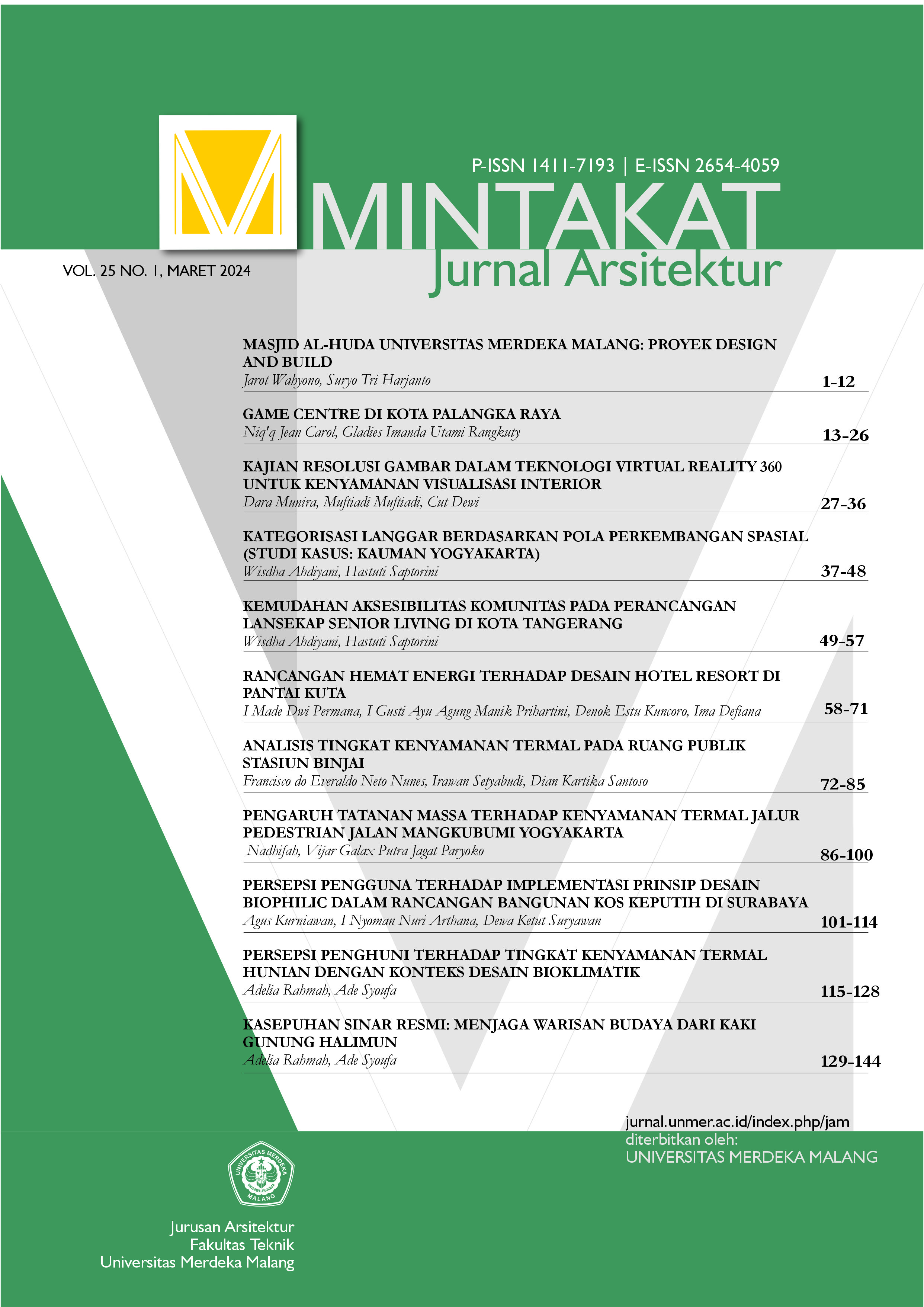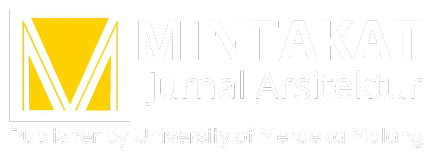Rancangan Hemat Energi terhadap Desain Hotel Resort di Pantai Kuta
DOI:
https://doi.org/10.26905/jam.v25i1.10880Keywords:
arsitektur berkelanjutan, Bali, EDGE, hemat energi, hotel resort, bangunan hijauAbstract
Hotel resort merupakan salah satu tipe bangunan dengan tingkat penggunaan energi yang cukup besar. Energi tersebut diperlukan untuk memenuhi kenyamanan pengunjung. Penggunaan energi yang besar akan berpengaruh pada biaya operasional lahan. Salah satu cara yang digunakan untuk menghemat penggunaan energi tersebut adalah dengan rancangan bangunan hotel resort yang hemat energi melalui penerapan konsep arsitektur berkelanjutan. Salah satu penerapan konsep berkelanjutan adalah melalui penghematan penggunaan listrik dan air. Paper ini menjelaskan penerapan hemat energi di hotel resort yang paling optimal. Metode kuantitatif digunakan untuk mendapatkan rancangan hemat energi melalui penggunaan simulasi dari aplikasi EDGE. Variabel yang digunakan meliputi panel surya, dimensi bayangan (shading), resapan air, dan sistem daur ulang air. Hasil menunjukan bahwa penerapan konsep hemat energi yang optimal untuk hotel resort adalah melalui persentase luas panel surya dari area atap, persentase shading dari lahan, penggunaan resapan air berdasarkan KDB, dan penggunaan proses daur ulang air.Downloads
References
Accetturo, A., Audrey, A., & Design, S. (2012), Rainwater Harvesting-Guidance Toward a Sustainable Water future. Bellingham: Public Works Department. DOI : https://cob.org/wp-content/uploads/rainwater-harvesting-booklet.pdf
Alhudaithi, M., Arregui, F.J., & Cobacho, R. (2022). Proposal of a Water Consumption Efficiency Indicator for the Hotel Sector. Water, 14(23): 3828. ISSN 2073-4441. https://doi.org/10.3390/w14233828
Alhuwayil, W. K, Mujeebu, M. A., & Algarny, A. M. M. (2019), Impact of external shading strategy on energy performance of multi-story hotel building in hot-humid climate. Energy, 169: 1166-1174. https://doi.org/10.1016/j.energy.2018.12.069
Armus, R., Fatmawati, Sappewali, Tanri, C.S., Muhlis, Aminah, S., Marzuki, I., & Kasim, A.H. (2023). Effectiveness of waste water treatment plant hotel. The 7th International Conference On Basic Sciences 2021 (ICBS 2021). ISSN 0094-243X. AIP Publishing. https://doi.org/10.1063/5.0111976
Betasolo, M., & Smith, C. (2020). Rainwater Harvesting Infrastructure Management. Environmental Health - Management and Prevention Practices. IntechOpen. https://doi.org/10.5772/intechopen.90342
Bhutta, F.M. (2012). Solar Energy Applications In Industrial And Commercial Sectors In Pakistan And Barrriers In Its Grow. https://www.altenergymag.com/article/2012/03/solar-energy-applications-
in-industrial-and-commercial-sectors-in-pakistan-and-barrriers-in-its-grow/1035/
Cedeno, R.C.B., & Wei, J. (2023), Theoretical Investigation Of The Mechanical Properties Of Perovskite At Various Environmental Factors Change For Application In Solar Cells Proposed For Green Policy. Engineering Analysis with Boundary Elements, 152: 326-333. https://doi.org/10.1016/j.enganabound.2023.04.017
D'Costa, D., Bakal, M., & Anvekar, T. (2021). Sustainable Recycling Of Hotel Waste Water In Goa. Paripex Indian Journal of Research, 10(03): 27-30. https://doi.org/10.36106/6805353
Delshad, S. (2015). Designing Country Hotel of Sarein by Using Solar Energy. European Online Journal of Natural and Social Sciences: Proceedings, 4(3). https://european-science.com/eojnss_proc/article/view/4432
Güğül, G.N. (2023). Optimum hybrid renewable energy system design for on and off grid buildings: Hotel, education and animal hospital building case. Solar Energy, 253: 414-427. https://doi.org/10.1016/j.solener.2022.12.044
Gupta A. R. (2012). A Step Towards Sustainable Water Management – Grey Water Reuse. https://www.engineeringcivil.com/a-step-towards-sustainable-water-management-grey-water-reuse.html
Hlaing, T.S., & Kojima, S. (2022). Comparative study on performance of wind-catcher shading device and other types of shading device on residential houses in tropics. International Journal of Sustainable Development and Planning, 17(6): 1705-1712. https://doi.org/10.18280/ijsdp.170603
Kunwar, N., & Mahabir, S.B. (2021). Simulation-based Energy and Daylighting Impact Assessment of Integrated Shading Devices and Lighting Controls in Commercial Buildings. International High Performance Buildings Conference. Paper 340. West Lafayette: Purdue University. https://docs.lib.purdue.edu/cgi/viewcontent.cgi?article=1339&context=ihpbc
Kyriaki, E., Drosou, V., & Papadopoulos, A.M. (2015). Solar Thermal Systems for Low Energy Hotel Buildings: State of The Art, Perspectives and Challenges. Energy Procedia, 78: 1968-1973. ISSN 1876-6102. https://doi.org/10.1016/j.egypro.2015.11.385
Leong J. Y. C. ,Oh K. S. ,Poh P. E., Meng Nan Chong M. N. (2017). Prospects of hybrid rainwater-greywater decentralised system for water recycling and reuse: A review. Journal of Cleaner Production, 142(4): 3014-3027. https://doi.org/10.1016/j.jclepro.2016.10.167
Mohammed, A. (2022). Study of Shading Device Parameters of the Mixed-Mode Ventilation on Energy Performance of an Office Building: Simulation Analysis for Evaluating Energy Performance in Egypt. In:
Rosso, F., Fabiani, C., Altan, H., Amer, M. (eds) Advances in Architecture, Engineering and Technology. Advances in Science, Technology & Innovation. Springer, Cham. https://doi.org/10.1007/978-3-030-86913-7_19
Payus, C., & Meng, K.J. (2015). Consumption Of Rainwater Harvesting In Terms Of Water Quality. International Journal of Geomate, 9(2): 1515-1522. ISSN:2186-2982(P). 2186-2990(O). Japan. https://doi.org/10.21660/2015.18.95782
Ramdan, M. (2021). Metode Penelitian. Surabaya: Cipta Media Nusantara.
Sassi, P. (2006). Strategies for Sustainable Architecture. New York: Taylor & Francis
Wang, F., Lin, H., & Luo, J. (2017). Energy Consumption Analysis with a Weighted Energy Index for a Hotel Building. Procedia Engineering, 205: 1952-1958. ISSN 1877-7058. Elsevier BV. https://doi.org/10.1016/j.proeng.2017.10.057
Zabidi, H.A., Goh, H.W., Chang, C.K., Chan, N.W., Zakaria, N.A. (2020). A Review of Roof and Pond Rainwater Harvesting Systems for Water Security: The Design, Performance and Way Forward. Water 2020, 12(11): 3163. https://doi.org/10.3390/w12113163














